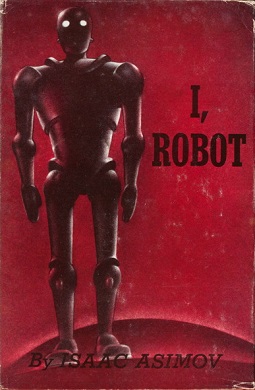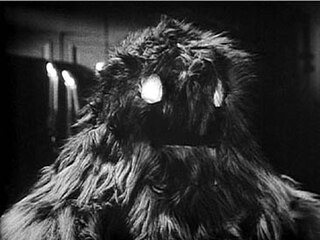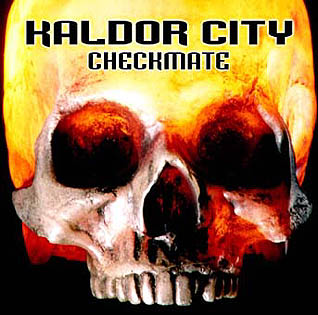
I, Robot is a fixup collection made up of science fiction short stories by American writer Isaac Asimov. The stories originally appeared in the American magazines Super Science Stories and Astounding Science Fiction between 1940 and 1950 and were then collected into a 1950 publication Gnome Press in 1950, in an initial edition of 5,000 copies.
The Mysterious Planet is the first serial of the larger narrative known as The Trial of a Time Lord which encompasses the whole of the 23rd season of the British science fiction television series Doctor Who. It was first broadcast in four weekly parts on BBC1 from 6 to 27 September 1986. The title The Mysterious Planet is not used on-screen and only appears in the serial's scripts with the four episodes that comprise the story being transmitted as The Trial of a Time Lord Parts One to Four.

The Yeti are fictional robots from the long-running British science fiction television series Doctor Who. They were originally created by Henry Lincoln and Mervyn Haisman, and first appeared in the 1967 serial The Abominable Snowmen, where they encountered the Second Doctor and his companions Jamie and Victoria.
Mawdryn Undead is the third serial of the 20th season of the British science fiction television series Doctor Who. It was originally broadcast in four twice weekly parts on BBC1 from 1 to 9 February 1983.
Enlightenment is the fifth serial of the 20th season of the British science fiction television series Doctor Who, which was originally broadcast in four twice-weekly parts on BBC1 from 1 to 9 March 1983. It was the 127th serial of the series, and was written by Barbara Clegg and directed by Fiona Cumming, making it the first serial to be both written and directed by women.
Horror of Fang Rock is the first serial of the 15th season of the British science fiction television series Doctor Who, which was first broadcast in four weekly parts on BBC1 from 3 to 24 September 1977.
Pyramids of Mars is the third serial of the 13th season of the British science fiction television series Doctor Who. Written by Robert Holmes and Lewis Greifer under the pseudonym of "Stephen Harris" and directed by Paddy Russell, the serial was first broadcast in four weekly parts on BBC1 from 25 October to 15 November 1975.

Leela is a fictional character played by Louise Jameson in the long-running British science fiction television series Doctor Who. She was a companion of the Fourth Doctor and a regular in the programme from 1977 to 1978. Leela appeared in nine stories.
Robot is the first serial of the 12th season in the British science fiction television series Doctor Who, which was first broadcast in four weekly parts on BBC1 from 28 December 1974 to 18 January 1975. It was the first full serial to feature Tom Baker as the Fourth Doctor, as well as Ian Marter as new companion Harry Sullivan. The serial brought a full end to the Pertwee era, as it was the final story with the production team of Barry Letts and script editor Terrance Dicks. It was also the final regular appearance of UNIT, who had become regulars starting with the first Jon Pertwee serial Spearhead From Space.

Kaldor City is a series of audio plays using elements from the British TV series Doctor Who and Blake's 7. Many of the elements borrowed from these series for use in Kaldor City were originated by Chris Boucher, who wrote for Doctor Who and was script editor for all four seasons of Blake's 7. The series, produced by Magic Bullet Productions, was released on CD beginning in 2001.
Peter Grimwade was a British television director and screenwriter, known for his work as a director and writer of the BBC science fiction television series Doctor Who in the 1980s.
The Talons of Weng-Chiang is the sixth and final serial of the 14th season of the British science fiction television series Doctor Who, which was first broadcast in six weekly parts on BBC1 from 26 February to 2 April 1977. In the serial, which is set in 19th-century London, the 51st century criminal Magnus Greel travels to the city and poses as an ancient Chinese god to find his missing time machine.
Earthshock is the sixth serial of the 19th season of the British science fiction television series Doctor Who. It was first broadcast in four twice-weekly parts on BBC1 from 8 to 16 March 1982. This serial marks the final regular appearance of Matthew Waterhouse as Adric and his climactic death, with the final episode featuring unique silent credits in memory of the character. It is also the first to feature the Cybermen since Revenge of the Cybermen in 1975.
Resurrection of the Daleks is the fourth serial of the 21st season in the British science fiction television series Doctor Who, which was first broadcast in two weekly parts on BBC1 between 8 February and 15 February 1984. The serial was intended to be transmitted as four 23-minute episodes but a late scheduling change by the BBC meant that it was transmitted as two episodes of 46 minutes; reruns restored it to its intended format.
Revenge of the Cybermen is the fifth and final serial of the 12th season of the British science fiction television series Doctor Who, which was first broadcast in four weekly parts on BBC1 from 19 April to 10 May 1975. It was the first to feature the Cybermen since The Invasion (1968) and the last until Earthshock (1982).
Image of the Fendahl is the third serial of the 15th season of the British science fiction television series Doctor Who, which was first broadcast in four weekly parts on BBC1 from 29 October to 19 November 1977.
The Invisible Enemy is the second serial of the 15th season of the British science fiction television series Doctor Who, which was first broadcast in four weekly parts on BBC1 from 1 to 22 October 1977. The serial introduced the robot dog K9, voiced by John Leeson. In the serial, an intelligent virus intends to spread across the universe after finding a suitable spawning location on the moon Titan.
The Sun Makers is the fourth serial of the 15th season of the British science fiction television series Doctor Who, which was first broadcast in four weekly parts on BBC1 from 26 November to 17 December 1977.

The fifteenth season of British science fiction television series Doctor Who began on 3 September 1977 with the episode Horror of Fang Rock, and ended with The Invasion of Time. The fourth series for the Fourth Doctor, new producer Graham Williams became producer for this series, while Robert Holmes left script editing for Anthony Read midway through.





